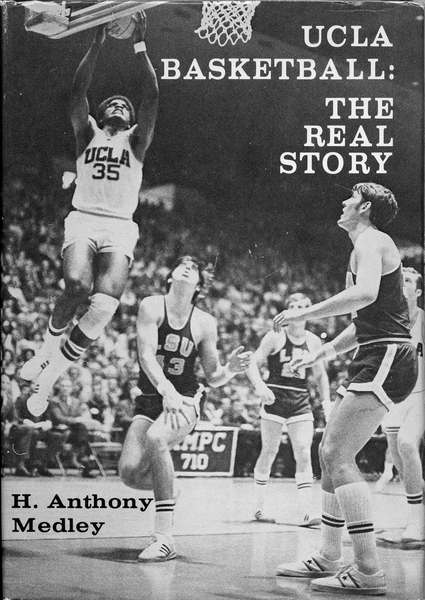|
Out of print for more than 30 years, now available for the first time as an eBook, this is the controversial story of John Wooden's first 25 years and first 8 NCAA Championships as UCLA Head Basketball Coach. Notre Dame Coach Digger Phelps said, "I used this book as an inspiration for the biggest win of my career when we ended UCLA's all-time 88-game winning streak in 1974." Compiled with more than 40 hours of interviews with Coach Wooden, learn about the man behind the coach. Click the Book to read the players telling their stories in their own words. This is the book that UCLA Athletic Director J.D. Morgan tried to ban. Click the book to read the first chapter and for ordering information. |
|
Casino Jack and the United States of Money (1/10) by Tony Medley Run time 118 minutes. Not for children. A key point to consider when watching this is that it’s made by writer/director Alex Gibney, who is responsible for Enron: The Smartest Guys in the Room (2005). That’s relevant because the entire Enron movie never once mentioned the name of California Democrat legislator Steve Peace. Nobody with any actual knowledge of what happened with Enron could make an entire movie about it without mentioning Peace because he wrote the California legislation that enabled Enron and caused the whole mess. But for Peace, there would have been no Enron. Making a movie about Enron and not mentioning Peace would be like making a movie about the founding of our Republic and not mentioning George Washington. So either Gibney was incredibly stupid, or had a pro-Democrat bias, and I have little doubt that the reason is bias. Gibney takes up here where he left off with Enron, because this is a clumsy hatchet job. The premises are that Republicans are corrupt and capitalism is evil. Because facts don't fully support this agenda (the latter, at least), Gibney intentionally makes this tale of disgraced lobbyist Jack Abramoff so convoluted it’s almost impossible to follow. He often shows interviews with people without further identifying them, or only identifying them once. Who can remember all these people? Worse, he never presents any information about where these people are coming from or if they have any political bias. There’s little doubt that Abramoff was corrupt, but so are a lot of people in Washington. Gibney makes it all look as if what Abramoff did was a conservative plot to take over Washington, mostly ignoring the fact that lots of Democrats were involved with him, too, and that there are Democrat lobbyists who are undoubtedly just as peccant as Abramoff. Gibney goes to extraordinary lengths to hoodwink his viewers. There are probably some gullible people who will fall into Gibney’s web and come away thinking that everyone pictured (including Ronald Reagan, and all conservatives) are just horribly iniquitous people and that the Democrats are all mostly simon pure. But the film is so clumsy that it only takes a grain of sense to see through it like a pane of glass. The film is peopled by interviews with devoted left-wingers. Prominently featured is Melanie Sloan, executive director of CREW (Citizens for Responsibility and Ethics in Washington). Melanie Sloan is hardly unbiased, having worked for John Conyers, the vitriolic leftwing Democrat from Michigan, and Charles Shumer, the partisan Democrat Senator from New York. Lest one think that CREW is fair and balanced, eight of the eleven governors who made its “worst” governors list were Republicans. Seventy Percent of the people named in its list of the 20 most corrupt members of Congress were Republicans. Prominently missing are Barney Frank and Chris Dodd, who enabled Fannie Mae and Freddy Mac and who (along with their President, Bill Clinton, who was cheering them on) are probably the two people most responsible for the financial meltdown caused by forcing banks to grant loans to people who couldn’t afford to pay them . They should be at the top of any list of corrupt members of Congress. Dodd realized he could never be reelected to his seat in the Senate and took the coward’s way out by chose not to run for it. But his name isn’t on Melanie’s list. Compare Melanie’s list with Judicial Watch’s list of the 10 most corrupt politicians of 2009, which included seven democrats, the aforementioned Messrs. Dodd and Frank, Jesse Jackson, Jr., Roland Burris, Nancy Pelosi, John Murtha, and Charles Rangel, and only one Republican, John Ensign. None of these Democrats made Melanie’s list of the top 20. Nobody in his right mind could doubt that Dodd and Frank belong at the top of any list of corrupt Members of Congress. Even so, Melanie appears throughout this thing as a talking head spouting her opinion which is represented as fact. Gibney clearly stacked the film with uninvolved people to interview who only support his virulent leftwing POV. Gibney does tell a story about the way Abramoff and associates took advantage of a naïve Indian group, and I remember that story. He quotes from emails and correspondence between and among Abramoff and his associates that sound particularly damning. But could they have been taken out of context? I wish I could rely on Gibney’s verisimilitude to believe this as shown, but after what he did with Enron, and because he limited the people he chose to showcase to those who all share the same tendentious POV, I can’t. This must be watched with heightened skepticism.
|
|
|
